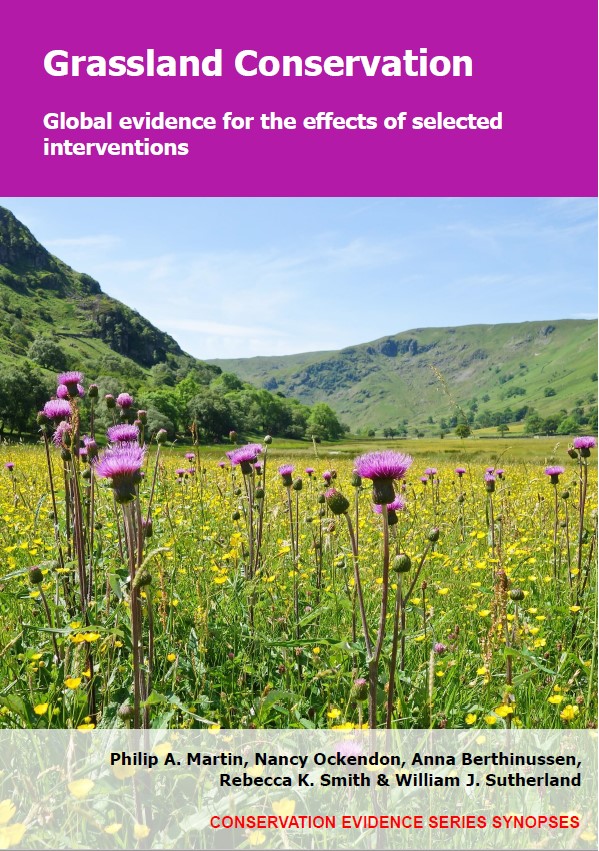Actions to conserve biodiversity
We have summarised evidence from the scientific literature about the effects of actions to conserve wildlife and ecosystems.
Review the evidence from the studies
Not sure what Actions are? Read a brief description.
Search for evidence
e.g. "frogs chytrid"
36 Actions found
Refine
Hide
36 Actions found
Download Actions
| 0 selected |
|
Order results by:
| Action | Effectiveness | Studies | Category | |
|---|---|---|---|---|
|
Use slot/strip seeding Action Link |
Evidence not assessed | 2 |
|
|
|
Use erosion blanket after seeding/planting Action Link |
Evidence not assessed | 3 |
|
|
|
Transfer plant material from intact grassland alongside seeding/planting Action Link |
Evidence not assessed | 4 |
|
|
|
Spray slurry of seed, mulch and water (‘hydroseeding’) Action Link |
Evidence not assessed | 4 |
|
|
|
Sow seeds of tree species in savanna Action Link |
Evidence not assessed | 1 |
|
|
|
Sow seeds of parasitic species (e.g. yellow rattle) Action Link |
Evidence not assessed | 6 |
|
|
|
Sow seeds of nurse plants Action Link |
Evidence not assessed | 1 |
|
|
|
Sow seeds in prepared gaps within vegetation Action Link |
Evidence not assessed | 1 |
|
|
|
Sow seeds in part of site Action Link |
Evidence not assessed | 3 |
|
|
|
Sow seeds at start of growing season Action Link |
Evidence not assessed | 3 |
|
|
|
Sow seeds at a higher density Action Link |
Evidence not assessed | 6 |
|
|
|
Sow or plant nurse plants (alongside seeding/planting of grassland species) Action Link |
Evidence not assessed | 4 |
|
|
|
Sow native grass and forbs Action Link |
Evidence not assessed | 50 |
|
|
|
Sow grassland seeds from a local source Action Link |
Evidence not assessed | 5 |
|
|
|
Sow grassland forb species Action Link |
Evidence not assessed | 1 |
|
|
|
Sow grass seeds Action Link |
Evidence not assessed | 13 |
|
|
|
Remove vegetation before seeding/planting Action Link |
Evidence not assessed | 2 |
|
|
|
Remove topsoil or turf before seeding/planting Action Link |
Evidence not assessed | 6 |
|
|
|
Remove leaf litter before seeding/planting Action Link |
Evidence not assessed | 3 |
|
|
|
Plant grassland plants Action Link |
Evidence not assessed | 4 |
|
|
|
Mow before or after seeding/planting Action Link |
Evidence not assessed | 10 |
|
|
|
Irrigate before or after seeding/planting Action Link |
Evidence not assessed | 2 |
|
|
|
Inoculate soil with mycorrhiza before seeding/planting Action Link |
Evidence not assessed | 5 |
|
|
|
Increase number of species in seed mix Action Link |
Evidence not assessed | 5 |
|
|
|
Graze with livestock after seeding/planting Action Link |
Evidence not assessed | 7 |
|
Download Actions
| 0 selected |
|

Grassland Conservation - Published 2021
Grassland Synopsis
Watch this search
If you are familiar with RSS feeds, please click the button below to retrieve the feed URL:
RSS feed for this searchIf you are unfamiliar with RSS feeds, we would suggest reading this BBC article.
Unfortunately, due to the number of feeds we have available, we cannot provide e-mail updates. However, you could use tools such as Feed My Inbox to do this for you.
What are 'Individual studies' and 'Actions'?
Individual studies
An individual study is a summary of a specific scientific study, usually taken from a scientific journal, but also from other resources such as reports. It tells you the background context, the action(s) taken and their consequences.
If you want more detail please look at the original reference.
Actions
Each action page focuses on a particular action you could take to benefit wildlife or ecosystems.
It contains brief (150-200 word) descriptions of relevant studies (context, action(s) taken and their consequences) and one or more key messages.
Key messages show the extent and main conclusions of the available evidence. Using links within key messages, you can look at the paragraphs describing each study to get more detail. Each paragraph allows you to assess the quality of the evidence and how relevant it is to your situation.
Where we found no evidence, we have been unable to assess whether or not an intervention is effective or has any harmful impacts.





)_2023.JPG)














